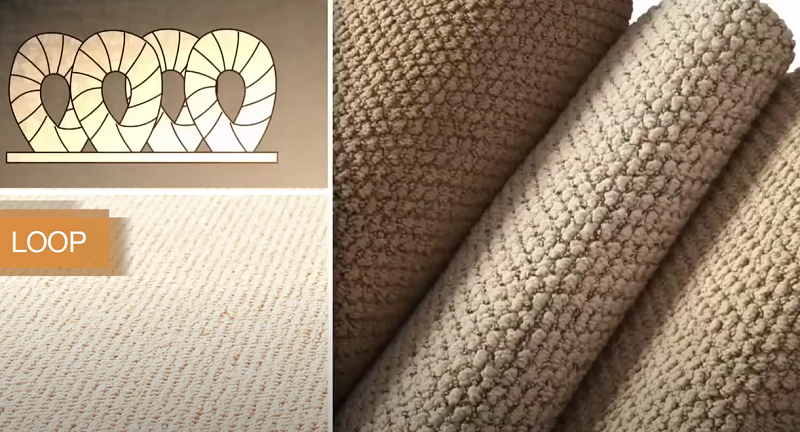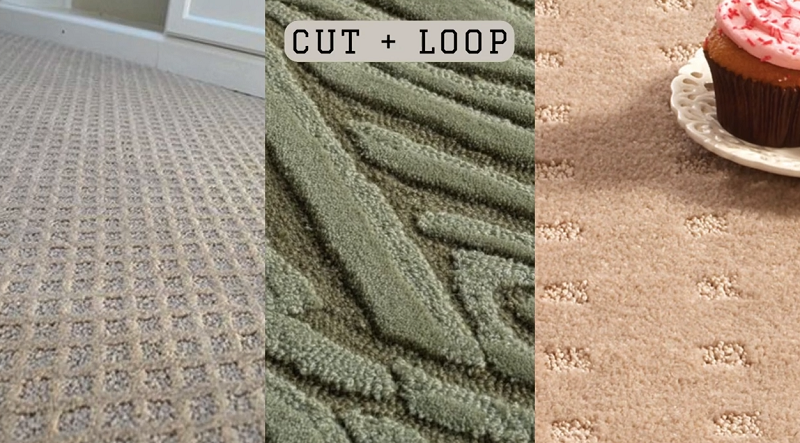NEWS TAG
brand
Cut Pile vs Loop Pile vs Cut Loop Carpet, Which Is The Best To Choose?
In the tapestry of home decor, carpets form a comforting baseline, a soft fabric that stretches across our living spaces, often taken for granted yet pivotal in shaping the aesthetic and feel of our rooms. As you stand at the threshold of choice, deciding on the perfect carpet can feel like navigating a labyrinth of textures, styles, and functionalities. Let’s unravel the threads of cut pile, loop pile, and cut loop carpets to find the weave that best suits your sanctuary.
Differences Between Cut Pile Carpet, Loop Pile Carpet, Cut and Loop Carpet
When it's time to transform a room, carpets are a comfortable, versatile, and stylish choice. When choosing the perfect carpet, it's important to consider where it will be going and how you will use the space. An important first step is getting to know the different types of carpet construction available. All carpets are constructed with different types of piles. The pile of a carpet describes its fibers. These can be Cut pile, loop pile, and loop cut loop or LCL carpets. Now let's break down each of these carpet styles to help you make the right choice!
1. What Is A Cut Pile Carpet?
Cut pile carpet is a style of carpet where the loops that are created during the weaving process are cut to expose the ends of the carpet fiber. This type of carpet comes in various lengths and thicknesses, offering a softer feel underfoot compared to loop pile carpets. The durability of cut pile carpets is achieved through the type of fiber used, the density of the tuft, and the amount of twist in the yarn. Highly twisted yarns hold their shape longer, making them an excellent choice for high-traffic areas. Cut pile carpets are perfect for creating a soft and inviting atmosphere in home offices, bedrooms, and formal living rooms. This style is mainly found in broadloom or wall-to-wall carpets.

Pros & Cons of Cut Pile Carpet:
Pros:
Softness: Cut pile carpets are generally softer underfoot compared to loop pile carpets.
Variety: Available in different lengths, thicknesses, and textures, offering a wide range of aesthetic options.
Durability: Highly twisted fibers increase the carpet's longevity, especially in high-traffic areas.
Comfort: Provides a cushioned feel, making it comfortable to walk on.
Cons:
Maintenance: May show footprints and vacuum marks more easily than loop pile carpets.
Cleaning: Certain types, like plush carpets, can be harder to clean due to their dense fiber structure.
Wear: Less durable in extremely high-traffic areas compared to some loop pile carpets.
Areas to Use
Cut pile is best used in areas like home offices, bedrooms, and formal living rooms where comfort is a priority and foot traffic is minimal.
Types of Cut Pile Carpets:
Plush Carpet: The most common name for cut pile carpet is plush. Plush carpets have a dense, soft texture and are usually found in living rooms. The yarn has relatively little twist, allowing the fibers to tuft or clump slightly, giving it a luxurious feel suitable for low-traffic areas.
Twist Carpet (Barber Pole): Twist carpets, also known as barber pole carpets, feature two plush fibers twisted around each other. This creates a unique look similar to a barber pole. Twist carpets are durable and can handle moderate foot traffic.
Shag Carpet: Shag carpets have a very long, loose pile, making them exceptionally soft. They provide a distinct look and feel but are less suitable for high-traffic areas due to their longer fibers.
Saxony Carpet: Saxony carpets use bulkier yarn fibers twisted tighter than plush carpets. This type of carpet resists matting and crushing while still providing a soft feel underfoot. Saxony carpets are ideal for areas with moderate traffic, such as dens and hallways.
Frieze Carpet: Frieze carpets have the tightest twist among cut pile carpets. The fibers curl slightly, creating a pebbled appearance. This type is extremely durable and resistant, making it a great choice for high-traffic areas in homes and workplaces.
Areas to Use Cut Pile Carpet:
Cut pile is best used in areas like home offices, bedrooms, and formal living rooms where comfort is a priority and foot traffic is minimal.
What Is Loop Pile Carpet?
Loop pile carpets are designed with loops of yarn that are pulled through the carpet backing and left uncut. These loops can be all the same height (level loop) or created at different heights (multi-level loop) to add texture and pattern to the carpet. Loop pile carpets are known for their strong, durable nature, making them suitable for high-traffic areas. The loop construction makes them resilient and able to maintain their appearance over time, resisting matting and crushing.

Pros and Cons of Loop Pile Carpets:
Pros:
Durability: Loop pile carpets are extremely durable and are well-suited for high-traffic areas due to their ability to resist matting and crushing.
Maintenance: They are relatively easy to clean and maintain, as the loop construction prevents dirt from embedding deeply.
Aesthetic Variety: Available in various styles and colors, loop pile carpets can complement many decor themes.
Cons:
Comfort: Compared to cut pile carpets, loop pile can feel harder underfoot, which might be less comfortable for some.
Snagging Risk: The loops can be pulled or snagged by pets’ claws or sharp objects, potentially damaging the carpet.
Types of Loop Pile Carpets:
Loop pile carpets come in various types, each offering unique aesthetic and functional benefits:
Level Loop: Also known as Berber, this type features loops of uniform height. It is prized for its neat, consistent appearance and durability.
Multi-Level Loop: These carpets have loops of varying heights to create patterns and texture. They can offer more intricate designs, such as abstract, geometric, or linear patterns.
Textured Loop: With a slightly informal look, textured loops use variations in loop height to create a patterned surface that helps hide dirt and footprints.
Areas to Use Loop Pile Carpets:
Loop pile carpets are incredibly versatile, making them suitable for various areas in a home or commercial space: High-Traffic Areas such as Hallways, family rooms, and playrooms, basements, commercial spaces including office buildings and other commercial settings.
What Is Cut Loop Carpet?
Cut loop carpet is a style of carpeting that combines high cut fiber and lower loop pile in one carpet resulting in a dense and plush surface, offering subtle patterns and textures that enhance its visual appeal. The distinct patterns are created by the variations in texture between the cut ends of the fiber and the looped sections. This design technique helps to minimize the appearance of wear and tear, making cut loop carpets particularly suitable for high-traffic areas.

Pros and Cons of Cut and Loop Carpet:
Pros:
Durability: The combination of cut and loop yarns provides a balance of softness and resilience, making these carpets durable against foot traffic.
Aesthetic Appeal: Cut loop carpets are known for their attractive patterns and textures that can complement any room’s decor.
Maintenance: The unique pattern designs help hide dirt, stains, and footprints, making these carpets easier to maintain compared to other styles.
Cons:
Cost: Cut loop carpets can be more of an investment compared to standard loop or cut pile carpets.
Snagging: Like any carpet with loops, there is a potential for snagging, especially in households with pets or sharp objects.
Types of Cut Loop Carpet:
Cut loop carpets come in various types, each offering a different aesthetic and functional benefit:
Textured Patterns: These carpets often feature designs like diamonds or other geometric shapes, created by the variance in yarn height and texture.
Randomized Patterns: Some cut loop carpets have low-profile, randomized patterns that offer a more subtle texture, suitable for a variety of decor styles.
Large Scale Patterns: These are more noticeable and can serve as a focal point in a room, designed with large, distinct patterns that stand out.
Areas to Use Cut and Loop Carpet:
Cut loop carpet is well-suited for high-traffic areas like hallways and entryways due to its durability and ability to hide dirt. Its elegant designs also make it ideal for enhancing the decor of living rooms, bedrooms, and professional environments such as offices, offering a balance of aesthetic appeal and functionality.
Cut Pile vs Loop Pile vs Cut Loop Carpet, Which One Is Better
Each carpet type has distinctive qualities that make them suitable for different environments and preferences. Here’s a simple breakdown:
Durability: Loop pile > Cut loop > Cut pile
Softness: Cut pile > Cut loop > Loop pile
Maintenance: Loop pile > Cut loop > Cut pile
Aesthetic Variety: Cut loop > Loop pile > Cut pile
Let's sum up the differences between them with the following table:
| Feature | Cut Pile Carpet | Loop Pile Carpet | Cut Loop Carpet |
|---|---|---|---|
| Durability | Low | High | Medium |
| Comfort | High | Medium | Medium-High |
| Maintenance | Medium | High | Medium |
| Aesthetics | Simple | Simple | Complex/Patterned |
| Best For | Bedrooms, Offices | Hallways, Basements | Living Rooms, High Traffic Areas |
Cut Pile vs Loop Pile vs Cut Loop Carpet, Which One Should You Choose?
Choosing between cut pile, loop pile, and cut loop carpets depends largely on your specific needs:
Traffic: For high-traffic areas, loop pile or cut loop carpets are excellent choices due to their durability.
Luxury and comfort: For spaces where comfort is essential, like bedrooms, cut pile carpets are ideal.
Design: If you want to add visual interest, cut loop carpets offer various patterns and textures.
Pets: Avoid loop pile carpets if you have pets, as their claws can get caught in the loops.
Ultimately the "best" carpet depends on your priority - comfort and aesthetics leans toward cut pile, while durability points to loop or cut loop styles. Consider each room's foot traffic level when deciding between these three popular constructions.
